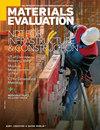用XRF验证外来物质的改进
IF 0.3
4区 材料科学
Q4 MATERIALS SCIENCE, CHARACTERIZATION & TESTING
引用次数: 0
摘要
尽管几十年来,各种常见的合金,如钢、钛和最近的铝,已经使用X射线荧光光谱(XRF)进行了测试和检查,但不常见和小众的合金可能会产生令人惊讶和不寻常的结果。识别这些合金中的基底金属、主要合金元素和微量材料的能力对XRF测试和检查程序至关重要。现代XRF仪器和软件可以快速轻松地表征标准和常见合金,如低碳钢、5级钛和6000系列铝;检测到的来自金属的信号通常是离散的并且非常明显。不太常见的合金,如镍超合金和铀,为快速现场测试、分级和检查提供了更大的分析障碍。这些外来材料要么含有来自合金元素的较弱信号,要么含有非唯一特征,从而妨碍了准确的量化。通过软件改进进行标准化调整,提高了这些不常见合金的测试精度,使其结果与更传统的合金一致。通过调节感兴趣的检测能量,鲁棒计算可以大大超过标准的开箱即用性能,而不需要任何检查员输入。这些改进可以在未来为更广泛的稀有和有价值的合金提供更高的检测精度。本文章由计算机程序翻译,如有差异,请以英文原文为准。
Improvement of Exotic Material Verification Using XRF
While various common alloys, such as steels, titaniums, and more recently aluminums, have been tested and inspected using X-ray fluorescence spectroscopy (XRF) for decades, uncommon and niche alloys can produce surprising and unusual results. The ability to identify the base metal, major alloying elements, and trace materials in these alloys is critical to XRF testing and inspection procedures. Modern XRF instruments and software can quickly and easily characterize standard and common alloys, such as low-carbon steel, grade 5 titanium, and 6000 series aluminum; detected signals from the metals are generally discrete and strongly pronounced. Less common alloys, such as nickel superalloys and uraniums, present a greater analytical hurdle for rapid on-site testing, grading, and inspection. These exotic materials contain either weaker signals from the alloying elements or nonunique signatures, preventing accurate quantification. Standardization adjustments through software improvements increase the testing accuracy for these uncommon alloys, bringing their results in line with those from more traditional alloys. By modulating the detection energies of interest, the robust calculation can greatly surpass standard, out-of-the-box performance without the need for any inspector input. These improvements can provide greater inspection accuracy on a wider variety of rare and valuable alloys into the future.
求助全文
通过发布文献求助,成功后即可免费获取论文全文。
去求助
来源期刊

Materials Evaluation
工程技术-材料科学:表征与测试
CiteScore
0.90
自引率
16.70%
发文量
35
审稿时长
6-12 weeks
期刊介绍:
Materials Evaluation publishes articles, news and features intended to increase the NDT practitioner’s knowledge of the science and technology involved in the field, bringing informative articles to the NDT public while highlighting the ongoing efforts of ASNT to fulfill its mission. M.E. is a peer-reviewed journal, relying on technicians and researchers to help grow and educate its members by providing relevant, cutting-edge and exclusive content containing technical details and discussions. The only periodical of its kind, M.E. is circulated to members and nonmember paid subscribers. The magazine is truly international in scope, with readers in over 90 nations. The journal’s history and archive reaches back to the earliest formative days of the Society.
 求助内容:
求助内容: 应助结果提醒方式:
应助结果提醒方式:


